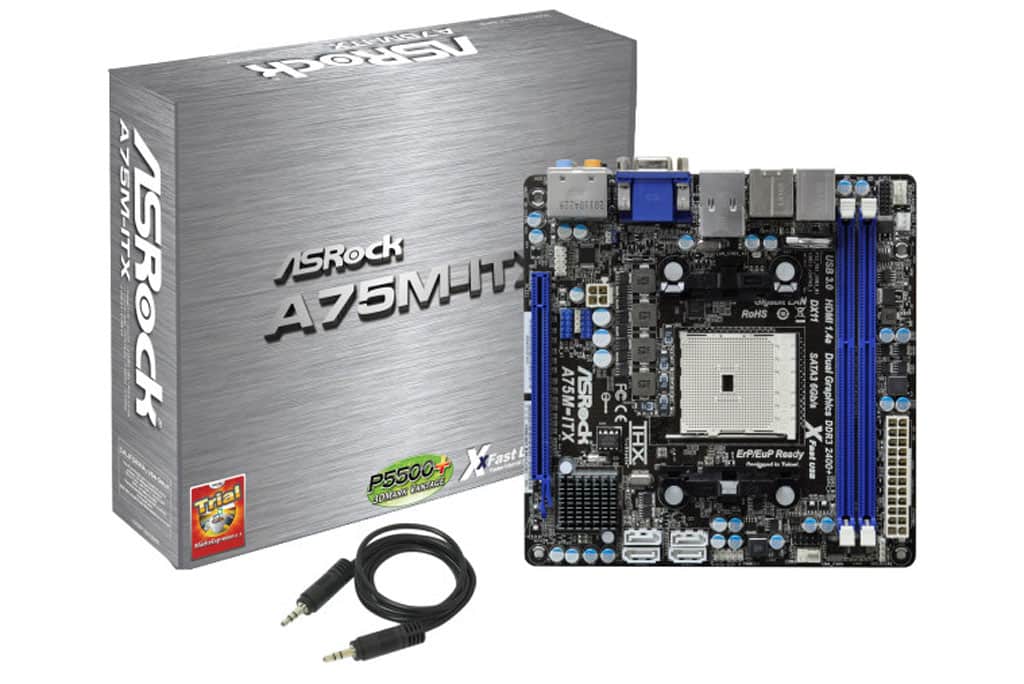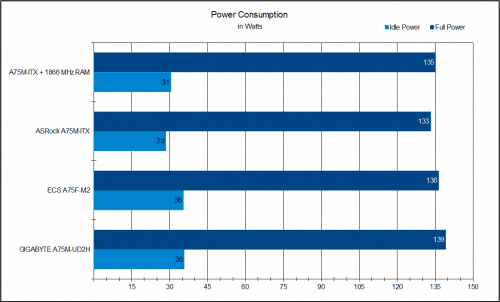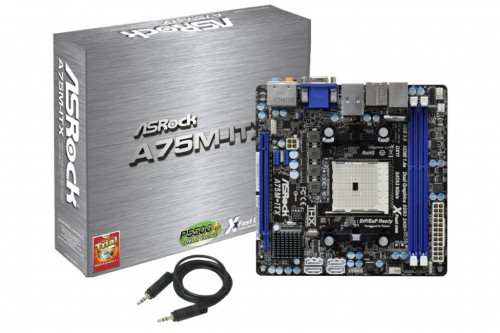Audio Performance (RightMark Audio Analyzer)
These test were done with an audio crossover cable linked from the primary speaker output to the mic input jack. In the near future will be altering my methodology on how I conduct this test, but this time I wanted to ensure the tests were all identical.
The A75M-ITX does a good job overall in audio performance. It does seem to struggle controlling noise and distortion, but makes up for it by producing very little noise in the first place. It also has the best dynamic audio range which is to be expect considering the Realtek chip on the ASRock is a ALC892 and the other two boards are using an ALC889.
Power Consumption
The power consumption test were done using a watt meter at the power socket for the entire system power draw. I then used the now tested results of the Antec 850 HCP to get closer to the power draw of the PC and not the amount of energy pulled by the PSU.
As expected, the mini-ITX sized ASRock A75M-ITX uses the least power at idle by 7 watts. The full power draw is also lower by 3 to 6 watts. The use of 1866 MHz RAM speed does bring the power up by 2 watts at both idle and full load.
Final Thoughts
Let me start off by saying I think the ASRock A75M-ITX is a great choice for HTPC builds. The only real draw back to using this board for such would be the lack of on-board WiFi, but this is easily remedied with a simple USB low profile WiFi Adapter. More adventurous users may even choose to adapt the internal headers for both Bluetooth and Wi-Fi if they wish. The board even has a CIR header for HTPC cases with built-in IR sensors.
The only time I found myself disappointed was with the THX TruStudio Software and overclocking. The THX software can simply never be installed as the Realtek audio control panel provides more than enough audio features. Speaking of software, I really wish that ASRock would discontinue including trial ware. If we wanted trial ware, we would buy our systems, not build them ourselves.
My issues with overclocking would only affect those looking to use the A75M-ITX for a desktop PC, and you shouldn’t really be using an ITX board for a PC build unless you have limitations on system size. To be blunt, overclocking seems to be too hazardous on this motherboard to the point that we think ASRock should put a warning label on it when going past the 110MHz mark on the bus.
The MSRP of $89.99 puts the ASRock A75M-ITX in the company of some great motherboards. To its advantage, ASRock provides one of the most useful software bundles on the market covering all aspects of using your computer. This board is clearly designed to be in an small form HTPC attached to an LCD TV and that environment is where it exceeds expectations. But overall, it loses points by not being as well rounded as the other boards and its inability to handle overclocking may point to some potential durability issues in harsher environments where a board like this may potential be used, where space is a premium and so is ventilation.
Pros:
- Mini-ITX form factor makes it fit nearly anywhere
- 3 fan headers for better cooling control
- Great Collection of Included Software
- Graphical UEFI BIOS Easy to Use
Cons:
- Overclocking is a bad idea on this board
- Does not include HDMI to DVI adapter
- Motherboard Layout can be Difficult to Work with
- Trial ware should never be bundled with DIY products
Overall Score: 7.0 / 10.0
Help Us Improve Our Reviews By Leaving a Comment Below



